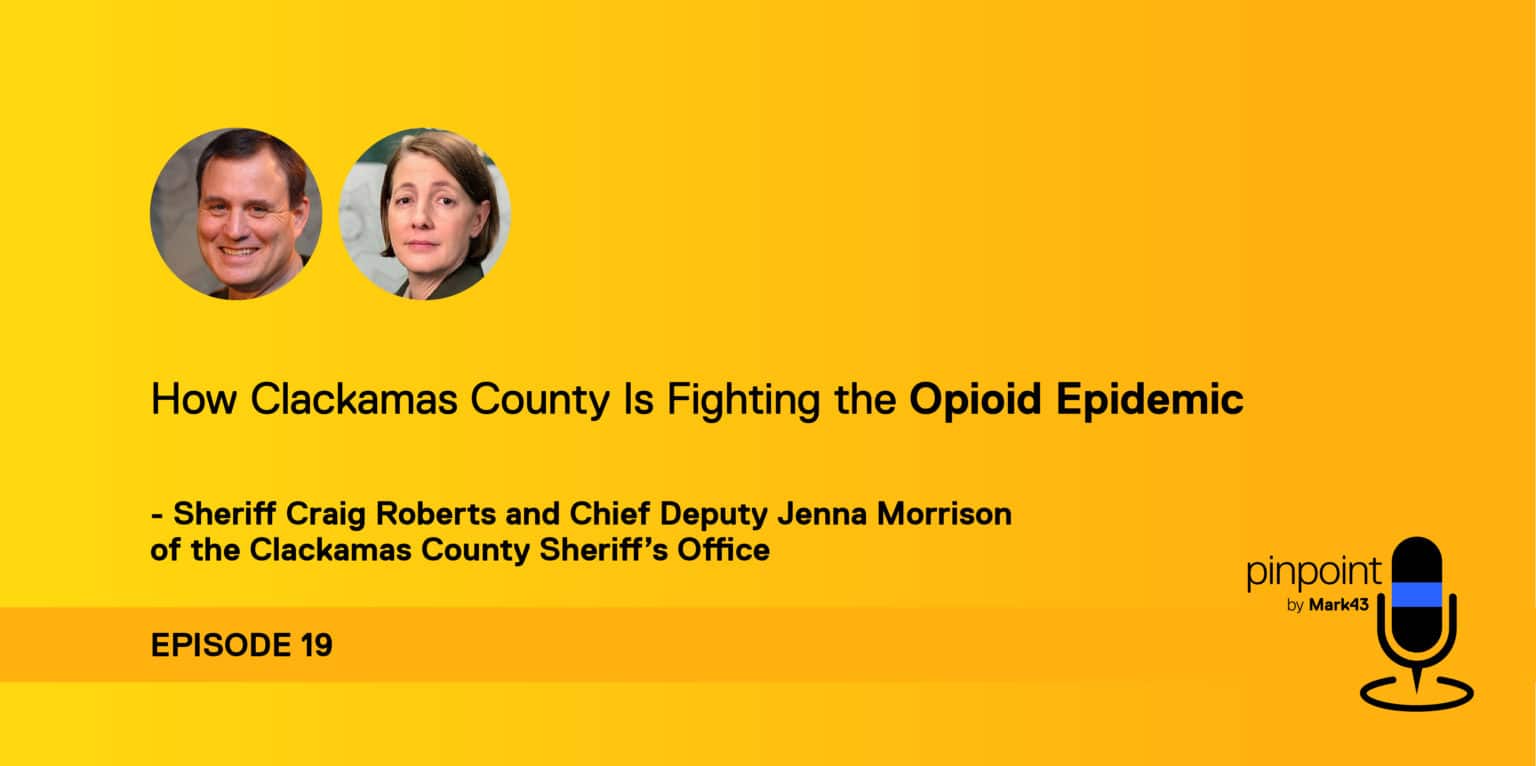Ep 19: How Clackamas County Is Fighting the Opioid Epidemic w/ Sheriff Craig Roberts and Chief Deputy Jenna Morrison
Kristen Goode | 01 September 2019 | 4 minute read

A 100% success rate for one year after graduation for women.
An 86% success rate for one year after graduation for men.
Those numbers are amazing enough if we were talking about education, but they’re truly one-of-a-kind for substance abuse programs.
I got to talk to Sheriff Craig Roberts and Chief Deputy Jenna Morrison of the Clackamas County Sheriff’s Office about the amazing success data of their Clackamas County Substance Abuse Program.
Sheriff Roberts has 40 years of law enforcement experience and has served as sheriff since 2005. Chief Deputy Morrison has over 20 years experience in law enforcement and earned the recognition of Parole and Probation Commander of the Year in 2016 from the Oregon State Sheriff’s Association.
Over the past five years alone, the Clackamas County substance abuse initiative has helped over 500 of the highest risk individuals and reduced crime while improving lives.
(function() { var qs, js, q, s, d = document, gi = d.getElementById, ce = d.createElement, gt = d.getElementsByTagName, id = 'soun_der', b = 'https://embed.sounder.fm'; if (!gi.call(d, id)) { js = ce.call(d, 'script'); js.id = id; js.src = b + '/embed.js'; q = gt.call(d, 'script')[0]; q.parentNode.insertBefore(js, q);}})();
<“Opioids break your brain, and so we have to have that first couple of months to let people heal.” —Chief Deputy Jenna Morrison>
How It Works
Because of the opioid epidemic of the last decade, Roberts has made a big change on focusing more on treatment. “There are so many people that we deal with in our population who either have mental health issues or mental health and addiction issues,” Roberts said.
They’re one of the only sheriff’s offices in Oregon and one of the few in the entire United States that even has a drug treatment program.
Their program is a year long, not the “spin dry” program that’s only a month. Individuals who have had some adverse life experiences can’t recover in just 30 days.
Roberts’s office emphasizes how treatment can impact the revolving door concept in substance abuse. “It’s the courts, it’s the DA’s, it’s defence, it’s the hospitals. An enormous amount of money is exhausted on this,” he said.
“By spending money up front on treatment, we’re seeing some really positive returns,” he added.
<“This coping mechanism of drugs and alcohol were oftentimes what they saw as the only way out.” —Sheriff Craig Roberts>
An Individualized Program
“One of the first things that we did to change our program was we made our program very individualized,” Morrison said. “There’s no set time limit that you’re in the program.”
Many participants stay in the residential part of the program for nine months or more.
“Opioids break your brain, and so we have to have that first couple of months to let people heal so that you can actually start participating in really making meaningful change in the treatment groups,” she added.
The program treats criminality as well as substance abuse. “We’re also challenging some of their core beliefs that keep them coming back to the criminal justice system,” Morrison said.
They also use prescription medication in treatment. Morrison acknowledges this position is controversial.
“We can’t continue asking people to be abstinence only. We’re working on a way for people to stop using heroin and illegal drugs and using other treatments that are medications to help people get through and off of these harder substances,” she said.
The Funding Question
How is a program this individualized and this successful funded?
In Oregon, many counties have to give their funding to the sheriff’s office to use for the jail. In Clackamas County, the funding that would normally go to the jail is what pays for the majority of the substance abuse program.
So, it’s all state and local dollars that fund this program.
Still, Roberts says he’s constantly looking for funding. “We get some general fund dollars from our county, and we look at grants and a number of other things to keep the program going,” he said.
But it’s been a struggle. “We should be expanding the program. Right now we have about 80 beds, and I can honestly use twice that.”
<“By spending money up front on treatment, we’re seeing some really positive returns.” —Sheriff Craig Roberts>
2 Huge Benefits of the Substance Abuse Initiative
For one, it really reduces crime.
“I can’t tell you the number of clients in this program that have told me that they would get up in the morning and their goal for that entire day was to get their next supply of heroin,” Roberts said. “And the only way that they could do that was by committing crimes.”
They’d break into 15 cars and 15 houses a day just to support their habits. “While they are in my system, we are reducing crime,” Roberts said.
Getting these clients to address their addiction issues has a direct impact on crime and protecting the community.
“We put the majority of our dollars towards our highest risk people,” Morrison added.
For another, it really serves the people struggling with addictions.
In talking to many of the women who participated in the program, Roberts said they were victims of horrific crimes. “It was pretty clear that this coping mechanism of drugs and alcohol were oftentimes what they saw as the only way out,” he said.
The county has a transition center in the same parking lot as the jail.
“We used to release them from the jail, give them a pat on the back, and wish them the best,” Roberts said.
Now, it’s completely different. “When they get released, a staff member actually walks them across the street to the transition center,” Morrison said.
They have access to coffee, bus fare, and a place to stay while they’re waiting–as well as professions who can offer a mental health assessment, narcan kits, and employment resources.
How to Get Started
A program like this doesn’t just grow out of thin air. It starts with working closely with health, housing, and human services. It’s absolutely critical.
It comes from partnering with health organizations, counselors, and nonprofits. “Our philosophy here is really working together to make that difference,” Roberts said.
One particular nonprofit that offers clean and sober housing also provides peer mentors, which Morrison said is monumental.
“Our clients tell us that having a peer to be able to bounce things off of, to relate to, to see someone who has been through the same criminal justice system substance abuse addiction and come through the other end is extremely powerful,” she said. “It helps them when they’re down, and it helps them move forward.”
Roberts and Morrison invite anyone interested in learning about or discussing implementing or improving a substance abuse initiative to call their office and visit.
Follow the Clackamas County Sheriff’s Office on Twitter and Instagram, visit their website, or call them at (503) 655-8218.
This post is based on a Pinpoint podcast with Sheriff Craig Roberts and Chief Deputy Jenna Morrison. To hear this and many other episodes, you can subscribe here.
If you don’t use Apple Podcast, you can find all our episodes here.




